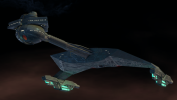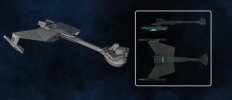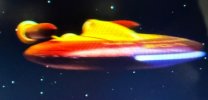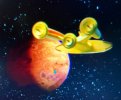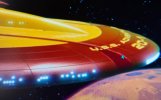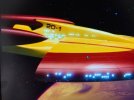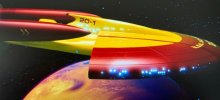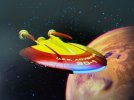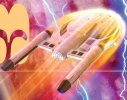It's canon, now, with PIC season 3 having the Constitution-III class (and by analogy confirming the refit as Constitution-II) and the Excelsior-II class. While there's a direct relationship between the Constitution-I and -II with at least one ship physically being rebuilt from the one class to the other, the Constitution-III and Excelsior-II are by all appearances totally unrelated to their predecessors. And that's not getting into the 32nd century ships that are, apparently, just Constitution-class and Intrepid-class, again. Probably Constitution-XII and Intrepid-VII, officially.There is some precedence in fan works for there being (II) subclasses or refits of existing ones, for whatever that might be worth.
-
Welcome! The TrekBBS is the number one place to chat about Star Trek with like-minded fans.
If you are not already a member then please register an account and join in the discussion!
You are using an out of date browser. It may not display this or other websites correctly.
You should upgrade or use an alternative browser.
You should upgrade or use an alternative browser.
Spoilers ST Strange New Worlds - Starships and Technology Season Three Discussion
- Thread starter Mark_Nguyen
- Start date
Battletech has done similar things over the years, with many capital ships getting at least one refit (block II variants), although the art problem between two of the technical manuals has arguably muddied some stuff over the years.  Basically when the second one was written, they couldn't find the art resources used for the first one and had to design entirely new art from scratch. This annoyed some fans because some of the designs (like the Black Lion; the newer Clan model is bottom center) don't look like a logical variant of the original, although mechanically they're not that different. Others like the Cameron and Sovetskii Soyuz designs do seem more plausible as refits, at least to me.
Basically when the second one was written, they couldn't find the art resources used for the first one and had to design entirely new art from scratch. This annoyed some fans because some of the designs (like the Black Lion; the newer Clan model is bottom center) don't look like a logical variant of the original, although mechanically they're not that different. Others like the Cameron and Sovetskii Soyuz designs do seem more plausible as refits, at least to me.
Part of the problem is that, in-universe, it's not clear when the Block I designs were replaced by the Block IIs in production. The Exodus Fleet which eventually evolved into the Clans has been variously depicted as using mainly 2750 type ships in one book and mainly 3057 ships in the companion book, even though they're part of the same set and written long after the tech books were published. So it's not a transitional issue as occasionally happened with the art in some of the early Clan books.
It's generally more common with mechs or vehicles, as those are sometimes direct updates of older units (like the original Marauder II) and sometimes more modern descendants of vintage designs like the Enforcer III. Many Clan variants of older Star League mechs as referred to as IIC models, although in many cases these have had significant hardware upgrades with Clan technology. Most standard vehicles will keep the original name and simply have newer series numbers to reflect variants and the incorporation of more modern systems, or will have a letter designation for omni units that carry modular equipment.
 Basically when the second one was written, they couldn't find the art resources used for the first one and had to design entirely new art from scratch. This annoyed some fans because some of the designs (like the Black Lion; the newer Clan model is bottom center) don't look like a logical variant of the original, although mechanically they're not that different. Others like the Cameron and Sovetskii Soyuz designs do seem more plausible as refits, at least to me.
Basically when the second one was written, they couldn't find the art resources used for the first one and had to design entirely new art from scratch. This annoyed some fans because some of the designs (like the Black Lion; the newer Clan model is bottom center) don't look like a logical variant of the original, although mechanically they're not that different. Others like the Cameron and Sovetskii Soyuz designs do seem more plausible as refits, at least to me.Part of the problem is that, in-universe, it's not clear when the Block I designs were replaced by the Block IIs in production. The Exodus Fleet which eventually evolved into the Clans has been variously depicted as using mainly 2750 type ships in one book and mainly 3057 ships in the companion book, even though they're part of the same set and written long after the tech books were published. So it's not a transitional issue as occasionally happened with the art in some of the early Clan books.

It's generally more common with mechs or vehicles, as those are sometimes direct updates of older units (like the original Marauder II) and sometimes more modern descendants of vintage designs like the Enforcer III. Many Clan variants of older Star League mechs as referred to as IIC models, although in many cases these have had significant hardware upgrades with Clan technology. Most standard vehicles will keep the original name and simply have newer series numbers to reflect variants and the incorporation of more modern systems, or will have a letter designation for omni units that carry modular equipment.
Do my eyes deceive me or are there multiple Saladin Class ships in this shot?


Do my eyes deceive me or are there multiple Saladin Class ships in this shot?

They’re not Saladins, they’re Archers. Different ship, similar layout.
Thanks for the clarification.
I think the designation Constitution-II had also shown up in both fan and licenced works prior to Picard Season 3
Edit: Yes, according to Memory-Alpha
So it was probably Doug Drexler's (Or Geoffrey's) influence that brought in the numbered designations into Picard.
Or maybe Dave Blass was just a fan.
Edit: Yes, according to Memory-Alpha
The "Constitution-II" designation first appeared in print in the concurrently published USS Enterprise Officer's Manual (p. 147, by Geoffrey Mandel and Doug Drexler), and the Star Trek Spaceflight Chronology (p. 180, by Rick Sternbach) reference books from 1980. At that particular point in time the term was in competition with the concurrent, but equally unofficial Enterprise-class designation. (see: here) Both Mandel and Drexler incidentally, worked four decades later as production staff on the third season of Star Trek: Picard during which the designation became officially adopted by their superior on the show, Production Designer Dave Blass.
So it was probably Doug Drexler's (Or Geoffrey's) influence that brought in the numbered designations into Picard.
Or maybe Dave Blass was just a fan.
Last edited:
Ships seen only in the opening credits:
1. Constitution class (some upside down)
2. ‘Nebula’ class
3. ‘Freighter’ class (some upside down)
4. ‘False Federation’ ship
Ships seen only in the episode:
1. Constitution class
2. Bellerophon class
3. Archer type
4. Kelcie Mae type
5. Crossfield class
6. Hiawatha type (round nacelles)
7. Malachowski class (round nacelles)
8. Nimitz class (round nacelles)
9. Shepard class (round nacelles)
10. ‘Larson’ class (Malachowski class with pylons bent upward with a single round nacelle)
11. Geronimo type shuttle/runabout
1. Constitution class (some upside down)
2. ‘Nebula’ class
3. ‘Freighter’ class (some upside down)
4. ‘False Federation’ ship
Ships seen only in the episode:
1. Constitution class
2. Bellerophon class
3. Archer type
4. Kelcie Mae type
5. Crossfield class
6. Hiawatha type (round nacelles)
7. Malachowski class (round nacelles)
8. Nimitz class (round nacelles)
9. Shepard class (round nacelles)
10. ‘Larson’ class (Malachowski class with pylons bent upward with a single round nacelle)
11. Geronimo type shuttle/runabout
As a Battletech fan since the 80s I've NEVER understood why they couldn't just open up a 2750 TRO or gone to the bookstore to buy a copy. Trying to justify the differences in most of the designs is like trying to convince someone that the 1980s Camaro in one book is really an Austen Mini in another.Battletech has done similar things over the years, with many capital ships getting at least one refit (block II variants), although the art problem between two of the technical manuals has arguably muddied some stuff over the years.Basically when the second one was written, they couldn't find the art resources used for the first one and had to design entirely new art from scratch. This annoyed some fans because some of the designs (like the Black Lion; the newer Clan model is bottom center) don't look like a logical variant of the original, although mechanically they're not that different. Others like the Cameron and Sovetskii Soyuz designs do seem more plausible as refits, at least to me.
Part of the problem is that, in-universe, it's not clear when the Block I designs were replaced by the Block IIs in production. The Exodus Fleet which eventually evolved into the Clans has been variously depicted as using mainly 2750 type ships in one book and mainly 3057 ships in the companion book, even though they're part of the same set and written long after the tech books were published. So it's not a transitional issue as occasionally happened with the art in some of the early Clan books.
It's generally more common with mechs or vehicles, as those are sometimes direct updates of older units (like the original Marauder II) and sometimes more modern descendants of vintage designs like the Enforcer III. Many Clan variants of older Star League mechs as referred to as IIC models, although in many cases these have had significant hardware upgrades with Clan technology. Most standard vehicles will keep the original name and simply have newer series numbers to reflect variants and the incorporation of more modern systems, or will have a letter designation for omni units that carry modular equipment.
Unless it's Comstar disinformation, which thankfully makes EVERYTHING make sense. Please pay your phone bills.
Mark
The newest model this week is a Klingon beacon. Other than that, there were reuses of existing models.
Probably a combination of hard to find and tight deadline, plus artists/managers at that time not really caring that much about consistency in such a "minor" property.As a Battletech fan since the 80s I've NEVER understood why they couldn't just open up a 2750 TRO or gone to the bookstore to buy a copy.
My understanding is that it was a matter of finding the original art resources in time for TRO: 3057, although that doesn't entirely explain why they couldn't have used an existing copy for reference. Perhaps it would have been too time consuming. It's a separate issue from the Unseen art problem, which has been somewhat resolved in various ways over the years.
The two-book Liberation of Terra set, which chronicles the Amaris Civil War through the Exodus and the Operation Klondike book describing the founding of the Clans, are the ones I referenced earlier as far as the art being inconsistent. I think the Klondike one, which exclusively uses the 3057 designs for early Clan fleets, had a different art crew from the Liberation books although you'd think there'd be more of a consistency rule. There's also some confusion about the art having the Clan version of the Vincent corvettes in the Exodus/Klondike era, even though the text from TRO 3057 specifically implies it to be a post-Exodus variant with a different model number.
There's also some confusion about the art having the Clan version of the Vincent corvettes in the Exodus/Klondike era, even though the text from TRO 3057 specifically implies it to be a post-Exodus variant with a different model number.
The two-book Liberation of Terra set, which chronicles the Amaris Civil War through the Exodus and the Operation Klondike book describing the founding of the Clans, are the ones I referenced earlier as far as the art being inconsistent. I think the Klondike one, which exclusively uses the 3057 designs for early Clan fleets, had a different art crew from the Liberation books although you'd think there'd be more of a consistency rule.
 There's also some confusion about the art having the Clan version of the Vincent corvettes in the Exodus/Klondike era, even though the text from TRO 3057 specifically implies it to be a post-Exodus variant with a different model number.
There's also some confusion about the art having the Clan version of the Vincent corvettes in the Exodus/Klondike era, even though the text from TRO 3057 specifically implies it to be a post-Exodus variant with a different model number.Thanks for listing them all.Ships seen only in the opening credits:
1. Constitution class (some upside down)
2. ‘Nebula’ class
3. ‘Freighter’ class (some upside down)
4. ‘False Federation’ ship
Ships seen only in the episode:
1. Constitution class
2. Bellerophon class
3. Archer type
4. Kelcie Mae type
5. Crossfield class
6. Hiawatha type (round nacelles)
7. Malachowski class (round nacelles)
8. Nimitz class (round nacelles)
9. Shepard class (round nacelles)
10. ‘Larson’ class (Malachowski class with pylons bent upward with a single round nacelle)
11. Geronimo type shuttle/runabout
Side note, STO has provided an official/non–canon name for the Hiawatha type. They call it the Hiawatha class.
Probably because CBS didn't give them one, assuming it had one.Thanks for listing them all.
Side note, STO has provided an official/non–canon name for the Hiawatha type. They call it the Hiawatha class.
Not the first time this has happened, the Farragut was always 'Bellerophon Class', it said it on the dedication plaque on the set. But since no-one from CBS gave them a name, they just called it the Farragut
Klingon Tricorder in the new epsiode

Sorry if this doesn’t count as Season 3,
but the recently released SNW novel “Toward the Night” that also introduced Noonien-Singh’s new season 3 given name “La’An”,
has provided a class designation for the 2257-era Disco D7 subclass: D7-A class / K’t’agga class.
Imho, this provides a great in-universe name option for disambiguation.
but the recently released SNW novel “Toward the Night” that also introduced Noonien-Singh’s new season 3 given name “La’An”,
has provided a class designation for the 2257-era Disco D7 subclass: D7-A class / K’t’agga class.
Imho, this provides a great in-universe name option for disambiguation.
Attachments
One of the new additiosn of this week was some kind of Federation sensor probes, which were launched from the Enterprise to observe the collapse of a neutron star. They appeared at the beginning of the episode, and were never mentioned or seen again as far as I can tell in the rest of the episode.
Then, there was the USS Adventure, the hero ship of the show "The Last Frontier".
Then, there was the USS Adventure, the hero ship of the show "The Last Frontier".
Now we understand why the 24th Century HoloDecks run on a completely different power source that is different from the rest of the ships EPS grid along with a dedicated server room for it.
We can thank Scotty for that.
We can thank Scotty for that.
Last edited:
I would like a model of this ship and I wonder if it could be playable in STO or whether the idea is too silly. The design reminds me a little of the 23rd century Archer class.
USS Adventure 20-1
USS Adventure 20-1
Attachments
Last edited:
Was "Motion Control" a thing when ST:TOS was being made?I think it would have been more of an homage if they had built a physical model and used motion control. But I doubt that was going to happen just for one scene.
Wasn't that a new technology at the time in the 1960's?
Early attempts at motion control came about when John Whitney pioneered several motion techniques using old anti-aircraft analog computers (Kerrison Predictor) connected to servos to control the motion of lights and lit targets. His film Catalog (1961) and his brother James Whitney's film Lapis (1966) were both achieved with John's pioneering motion control system. The 1968 film 2001: A Space Odyssey pioneered motion control in two respects. The film's model photography was conducted with large mechanical rigs that enabled precise and repeatable camera and model motion. The film's finale was created with mechanically controlled slit-scan photography, which required precise camera motion control during the exposure of single frames.
The first large-scale application of motion control was in Star Wars (1977), where a digitally controlled camera known as the Dykstraflex performed complex and repeatable motions around stationary spaceship models. This enabled a greater complexity in the spaceship-battle sequences, as separately filmed elements (spaceships, backgrounds, etc.) could be better coordinated with one another with greatly reduced error. The development of the Dykstraflex was led by John Dykstra, who had numerous contributors, including Alvah J. Miller and Jerry Jeffress. In 1978, Dykstra, Miller, and Jeffress won the Academy Award for Best Visual Effects.
If you are not already a member then please register an account and join in the discussion!

